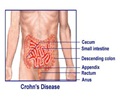Potentially unnecessary use of the tests among emergency room patients with abdominal pain may be reduced by a new electronic medical record tool

Abdominal pain is the most common reason why people seek care in emergency rooms in the United States, accounting for 10 million visits each year. But the symptoms may be caused by myriad problems, from those that can be fixed with a single dose of an over-the-counter drug to those that could prove life-threatening within hours: from a bout of GI distress to an ectopic pregnancy; from constipation to an appendix about to burst; from a hernia to signs of a chronic condition like Crohn's disease.
This complex diagnostic face-off plays a huge role in why emergency physicians tend to lean heavily on tests like CT scans, even though they expose patients to radiation and there are few clear guidelines on which patients should get them. Since the mid-1990s, the use of CT scans to diagnose ER patients has surged, increasing ten-fold. Today, 14 percent of all emergency room patients get scanned – a statistic experts often point to as a contributor to ballooning health care costs.
"Most patients with abdominal pain aren't in major danger, but some of the conditions that are on the list of things we consider as causes can be fatal within a short amount of time," said Angela M. Mills, MD, an assistant professor of Emergency Medicine and medical director of the emergency department at the Hospital of the University of Pennsylvania. "We need to be sure about our diagnosis in order to keep patients safe, but we need to balance the risks of giving a test like a CT scan with the chance that the test will truly provide us with information we could not get in some other way with less risk to the patient."
The Penn researchers investigated a new tool embedded within patients' electronic medical records that walked physicians through a series of questions that served as checks and balances for their decision to order a CT scan to investigate a patient's abdominal pain. They were queried, for instance, on what diagnosis they were trying to look for (from appendicitis to colitis to an ovarian cyst or tumor), and how likely they thought it was that the patient actually had that problem. And if a medical resident ordered the test, it had to be approved by an attending physician before the patient could receive the scan. Those steps, the researchers said, appeared to play a role in prompting the care team to rethink their choice of tests.
The authors studied 11,176 patients seen in two Penn Medicine emergency rooms between July 2011 and March 2012. Prior to implementing the new "accountability tool," 32.3 percent of patients seen received CT scans. After its use was adopted, the number dropped to 28 percent. After adjusting for various confounding factors, the researchers determined that patients were 10 percent less likely to undergo a CT scan after the tool was built into the electronic medical record. The patients were no more likely to be admitted to the hospital – a common occurrence when a diagnosis remains unclear – after adoption of the tool.
Advertisement
"For many patients, like those who are older or have cancer, this tool might not make a difference," Mills said, "but there are many abdominal patients who are younger, healthier, and who have things that are usually not life-threatening like kidney stones, for whom we are hoping this will reduce their exposure to unnecessary radiation."
Advertisement
Source-Eurekalert











